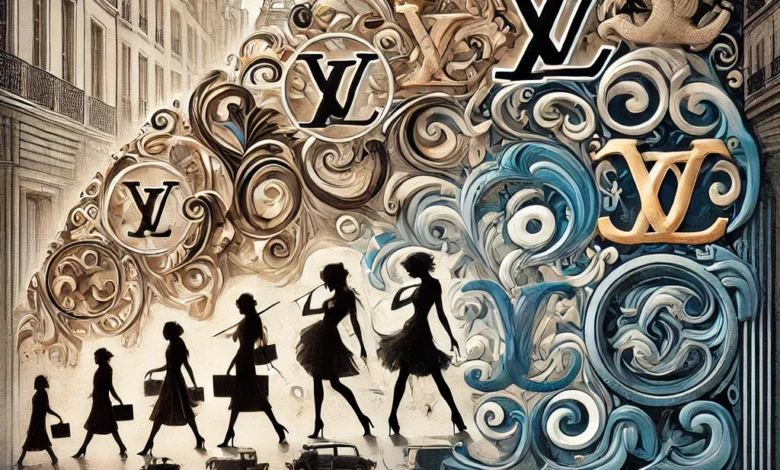The Evolution of French Fashion Monogram Since 1962: A Legacy of Luxury and Exclusivity

French fashion has long been a symbol of elegance, sophistication, and exclusivity. Among the many facets that define French luxury, the use of monograms has stood out as an iconic element in the branding of its finest fashion houses. French fashion monogram since 1962 have played a pivotal role in defining the identity of some of the most renowned luxury brands in the world. Through these carefully crafted symbols, fashion houses have communicated their heritage, quality, and prestige, making monograms a lasting hallmark of French fashion.
I. The Rise of Monograms in French Fashion
The concept of monograms as a means of branding and identification has been a part of French luxury fashion for centuries. It was during the late 19th and early 20th centuries that iconic fashion houses began to use monograms as a way of securing their place in the highly competitive world of luxury. French fashion monogram since 1962 is deeply rooted in a tradition that has seen these symbols evolve into powerful representations of status and exclusivity.
In the early days, monograms were not just decorative but served a functional purpose, protecting the ownership of high-value items like luggage and bags. Louis Vuitton, for instance, was one of the first brands to use its monogram as a way of ensuring that its products were easily identifiable. These early monograms would evolve over time to become much more than a simple label; they became symbols of luxury that would be recognized and coveted around the world.
Monograms were also used as a mark of quality craftsmanship. Fashion houses such as Chanel, Louis Vuitton, and Christian Dior began to use their initials in unique designs that not only reflected the high-quality materials and meticulous construction of their products but also emphasized their status as leaders in the luxury industry. French fashion monogram since 1962 have been integral in reinforcing this sense of heritage and craftsmanship.
Read Also: Pink Ardmore Nail Polish: A Vibrant Choice for Stylish Nails
II. Iconic French Fashion Monograms Post-1962
French fashion monograms since 1962 have undergone significant evolution, and many iconic designs have been born from this period. The most well-known French fashion monograms have become synonymous with luxury and exclusivity, and each brand has its own unique history and legacy.
A. Louis Vuitton (LV)
Louis Vuitton’s monogram, introduced in 1896 by Georges Vuitton, is perhaps the most famous in the world. The “LV” monogram, featuring interlocking letters alongside a floral pattern, has stood the test of time and remains a symbol of luxury even today. By the time the 1960s rolled around, the LV monogram was already a recognizable emblem of French fashion, appearing on high-quality luggage and leather goods.
The French fashion monogram since 1962 played a key role in establishing Louis Vuitton as the go-to brand for those seeking stylish and exclusive travel accessories. Over the years, Louis Vuitton has collaborated with artists such as Takashi Murakami and Jeff Koons to refresh and reinterpret the iconic monogram, keeping it relevant in the modern fashion world.
B. Chanel (CC)
The interlocking “C” logo of Chanel is another example of a French fashion monogram that has become synonymous with timeless luxury. Coco Chanel first used the “CC” monogram in the early 1920s, but its cultural significance truly grew in the 1960s as Chanel’s influence on global fashion expanded. The monogram, now a staple of luxury handbags, jewelry, and other accessories, symbolizes the ultimate in chic elegance and refinement. French fashion monogram since 1962 has become a hallmark of sophistication, with the CC logo appearing prominently on Chanel’s most coveted pieces. The interlocking “C” has become so ingrained in fashion culture that it is now considered one of the most iconic symbols of luxury fashion.
C. Christian Dior (CD)
Christian Dior’s monogram, which uses the “CD” initials, first came into prominence in the 1950s but saw greater adoption and recognition in the 1960s. The “CD” monogram became closely associated with Dior’s luxurious and feminine designs, which defined the fashion trends of the era. By the 1960s, Dior’s use of its monogram was firmly established, adorning everything from handbags to scarves. French fashion monogram since 1962, particularly Dior’s “CD” design, played a crucial role in cementing the brand’s place as one of the leading French fashion houses, recognized for its haute couture and ready-to-wear lines.
D. Saint Laurent (YSL)
The YSL monogram was designed by the French artist Cassandre in 1961, shortly after Yves Saint Laurent founded his own brand. The monogram combines the letters “Y,” “S,” and “L” in an elegant and modern design, which perfectly reflected the youthful spirit and revolutionary designs of the brand. By the 1960s, the YSL monogram had become a symbol of chic sophistication and avant-garde fashion. French fashion monogram since 1962 has continued to evolve, with the YSL logo becoming an enduring symbol of high fashion. The monogram has remained central to the brand’s identity, featured prominently on products ranging from leather goods to ready-to-wear collections.
III. The Role of Monograms in Luxury Fashion Today
Today, French fashion monogram since 1962 continues to be an essential part of luxury branding. These monograms are not only recognized worldwide but also play a significant role in defining the identity of the fashion houses that use them.
A. Monograms as a Status Symbol
In the world of luxury fashion, a monogram is much more than just a logo. It is a symbol of status, wealth, and exclusivity. French fashion monogram since 1962 has been closely tied to the notion of high social standing, with the use of monogrammed goods often signaling membership in an elite group. Brands like Louis Vuitton and Chanel, with their iconic monograms, have cultivated a sense of exclusivity that makes their products highly desirable to those seeking to showcase their taste and prestige.
B. Evolution of Monograms in Modern Fashion
While the traditional French fashion monogram since 1962 has remained largely consistent in its design, the way these logos are used has evolved. In recent years, collaborations with artists, limited-edition releases, and bold reinterpretations of classic designs have breathed new life into these iconic logos. Louis Vuitton, for example, has embraced a more contemporary approach by working with street artists and pop culture icons to make its monogram feel more relevant to younger, trend-conscious consumers. This evolution of the monogram reflects the ways in which French fashion continues to innovate while staying rooted in its heritage.
C. Monograms Beyond Fashion
In addition to their role in clothing and accessories, French fashion monogram since 1962 has expanded into other areas, including home décor, watches, and even technology. Luxury brands like Louis Vuitton and Hermès have used their monograms to create high-end products that extend beyond traditional fashion items. This diversification has helped cement the monogram as a symbol of total luxury, not just within fashion but across a wide range of premium products.
IV. The Enduring Legacy of French Fashion Monograms
The continued prominence of French fashion monogram since 1962 is a testament to their lasting impact on global fashion. These symbols have become not just logos, but cultural icons that represent a particular lifestyle and taste. French fashion houses have successfully maintained the appeal of their monograms by staying true to their heritage while adapting to the changing needs of their customers.
A. Continued Popularity and Iconic Status
Monograms have remained popular because they represent more than just a brand; they represent a story, a heritage, and a promise of quality. The French fashion monogram since 1962 has become synonymous with luxury, with brands like Chanel, Louis Vuitton, and Dior continuing to build on their monogram legacies. Even today, these monograms are highly coveted, with products bearing them fetching premium prices.
B. The Future of Monograms in French Fashion
As the fashion industry evolves, so too will the role of monograms. However, one thing remains certain: the legacy of French fashion monogram since 1962 will continue to shape the future of luxury fashion. Whether through collaborations, digital platforms, or new product categories, these monograms will remain at the heart of French fashion’s identity, continuing to represent the pinnacle of luxury and exclusivity.
Conclusion
The French fashion monogram since 1962 has evolved into a powerful symbol of luxury and heritage. From Louis Vuitton’s iconic “LV” to Chanel’s timeless “CC,” these monograms have become inseparable from the brands they represent. As French fashion continues to push boundaries, the monogram remains a central part of its identity, reflecting both the rich history and forward-thinking innovation that define these legendary houses. The enduring legacy of French fashion monograms ensures that they will remain icons of luxury for generations to come.
